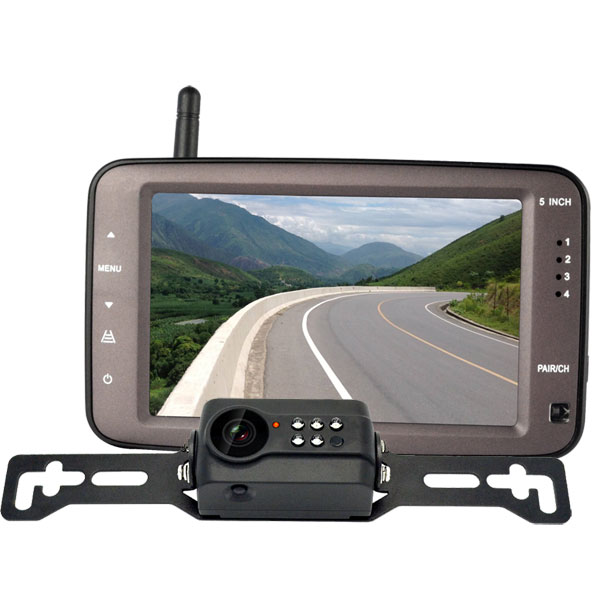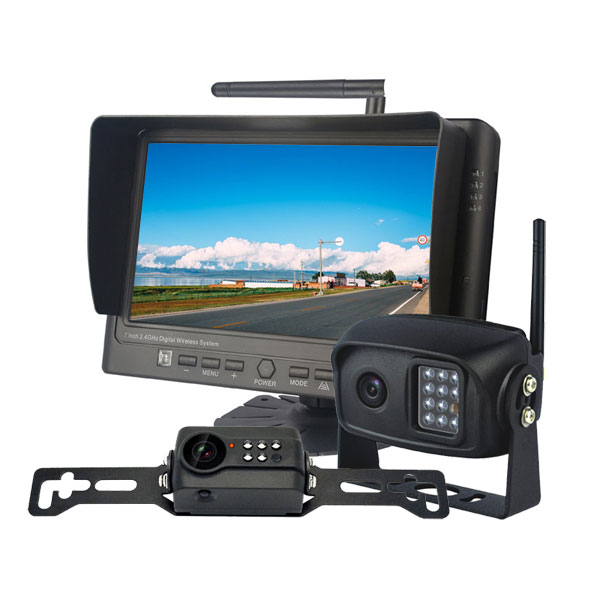Wireless Backup Camera System Troubleshooting Guide
Wireless Backup Camera System Troubleshooting guide
When it comes to wireless backup camera systems, the majority of the problems can be categorized under 3 major groups, they are:
1. No Display Issues (Backup camera system is not working, no display on monitor.)
2. Image Quality Issues (Backup camera system is working, but image quality is bad.)
3. Miscellaneous Issues (Other problems.)
By understanding the problem with your vehicle’s wireless backup camera system, and knowing which of the 3 groups it fits into, you will be better equipped to deal with the situation.

Following are troubleshooting topics for each of the 3 groups.
1. No Display Issues
If your wireless backup camera system suddenly stops working, or if you have just installed it, and done everything correctly, but you are seeing no images on the display, then it could be caused by any of the following:
– Monitor Issue
The problem could be from the receiver/monitor and not from the camera/transmitter side of the system.
This means that you should check that the monitor is properly connected with a power source, and that you can power it up.
If you cannot power it up or if it displays any error message, then the monitor is most probably the culprit.
If the monitor powers on, and you can see that it is working, but you are not able to receive any signals, check to see that its antenna is not broken and that it is properly connected to the monitor system.
– Camera/Transmitter Issue
If the monitor is alright, and the problem persists, then the camera/transmitter could be the culprit.

In this case, you should carry out a physical check of the camera module in your vehicle’s rear.
Check to make sure that the antenna is intact, and there is no physical damage of any kind to the module.
If there is no physical damage to the camera/transmitter, but it was previously functional, then its electronic components must be defective. If you are installing it for the first time, then check if you can receive its signal with another monitor or not.
– Connection Issues
It might happen that both camera and monitor are working perfectly fine. But they are not communicating with each other.
If you use an extra receiver module, then check that it is properly plugged into the monitor’s correct channel input. You could also try changing to another input to see if it works.
If the monitor integrates the receiver, then there could probably be pairing issues.

Different systems have different pairing and unpairing methods, so check your backup camera’s user guide, for pairing instructions.
2. Image Quality Issues
Your vehicle’s wireless backup camera system could be working, but there are problems with the quality of the image displayed on the monitor. In such a situation, check the following:
– Wireless Interference
One drawback of wireless systems, including backup camera systems, is interference.
Since wireless signals travel in the open air, and many gadgets utilize the 2.4Ghz and 5Ghz frequencies, any baby monitor, cordless phone, wireless security camera and wifi-router in the vicinity of your vehicle will cause a level of signal interference.
The possible remedies to wireless interference include disabling the second signal source, removing the signal source from the vehicle’s vicinity, and completely vacating the area, if access to the source of the interfering signals is out of reach.
If you are using a camera system with a separate transmitter module, then you could also try bringing the transmitter closer to the monitor, while leaving the camera in its position.
– Dirty or Smudged Images
Environmental influences can also cause a signal deterioration. Such influences include dust and mud, which could either partially or entirely block the camera’s view. Other situations like rainstorms can also degrade a wireless backup camera’s quality.
If the monitor’s image looks dirty, try wiping it with a piece of cloth. If you are experiencing adverse weather conditions, have some patience.
– Faint or Grainy Images
If, for some reason, your monitor displays faint images, or faint and grainy images, then you might have a weak signal problem.
This is especially true with analog wireless camera systems. Most wireless backup systems have ranges up to 150 feet, but it is usually in a line-of-sight situation.
If there are serious or thick obstacles between your camera/transmitter and your receiver/monitor, then you have to reduce the obstruction, or simply bring the two parts of the system closer.
3. Miscellaneous Issues
– System Not Working with Reverse Gear
Most modern backup camera systems are designed to switch on only when the reverse gear has been engaged.
If your monitor is constantly on, then you have not connected the system properly.
There are usually 2 cables for power (+ and -), then there is a reverse detection wire. You have to power the monitor with the 2 power cables, then connect the reverse detection wire to the reverse light of your vehicle.
This reverse cable can either be from the camera, if the monitor is designed to receive reverse signals from the camera, or the cable can run straight from the monitor to the reverse light.
– Monitor Flickers When Not In Reverse
If your monitor displays well when you are in reverse, but flickers when you are not in reverse, then you need to check your vehicle’s wiring.
This usually happens in older systems without a reverse detection wire, where either the camera or the monitor will be powered directly from the reverse light cable.
Some reverse wiring will act funny when a bulb blows for example, and there will be a few volts available on the cable.
This voltage might not be enough to power on the monitor, but it will be just enough to make it flicker.
– No Infrared Images
If it is night and you are not getting any infrared images, then there is probably too much light behind you.
Infrared systems require darkness to work well, and they even have a sensor that only switches on the infrared led-illuminators, only when it is dark enough.
Conclusion
We have come to the end of this wireless backup camera systems troubleshooting guide.
Since manufacturers and wireless backup camera systems vary, there might be situations that you are experiencing, which is not explicitly listed above.
In such a case, you will be well served to use your imagination, based on the guidelines above, to solve the problem.
